Corona Renderer v7 HF2 for Cinema 4D And Material Library
Corona Rendering Extension for Cinema4D
Corona Renderer is a rendering tool that can be said to be one of the most successful and best rendering engines in the world today, and its main focus is on the speed of rendering operations. Corona’s image editor also allows you to work with images outside of 3D apps. Given that Corona uses CPU power for processing, setting up a scene is so simple that anyone can use it without requiring too much knowledge. In exchange for that, the quality you will get will also be stunning.
Key features of the Corona Renderer plugin:
– Generate realistic high-quality renders
– Easy configuration and fast operation to achieve the final product
– Integration with Cinema 4D
– CPU-based and independent of GPU
limitations – Noise cancellation and reduction in the number of passes needed to get a noise-free image
– etc.
System Requirements
Hardware Requirements For Corona Renderer 4
– For Corona Renderer 4, you will need a CPU that supports the SSE4.1 instruction set (any processor from within the last 10 years).
– To use our optional Fast Preview Denoiser (NVIDIA OptiX), you need an NVIDIA GPU with Maxwell or newer architecture and the newest GPU driver. Not all mobile GPUs are supported.
Note: this denoiser type is optional, and Corona Renderer will work fine even if it’s not installed (for example if you are using an AMD or integrated GPU). We also offer a High Quality denoiser, which utilizes purely the CPU, and this denoiser can be used on any computer which can run Corona Renderer.
– There are no further specific hardware requirements.
Software Requirements MAXON Cinema 4D version
– Cinema 4D version: MAXON Cinema 4D R14-R21
– 64-bit Microsoft Windows (7, 8, 8.1, 10)
– Installation requires administrator privileges
– Distributed rendering also requires matching Backburner version
– GPU Denoiser: to ensure smooth operation and best performance of our Fast Preview Denoiser (NVIDIA OptiX), please make sure you are using the newest driver available for your graphics card.
Requirements for Corona Renderer 6 HF2:
Basic Facts
– Corona Renderer is entirely CPU based (with optional GPU denoising which requires a compatible NVIDIA GPU)
– Offers unbiased and biased rendering
– The two commercially available plugins work with 3ds Max and Cinema 4D
Hardware Requirements
– For Corona Renderer 2 and newer, you will need a CPU that supports the SSE4.1 instruction set (any processor from within the last 10 years).
– To use our optional Fast Preview Denoiser (NVIDIA OptiX), you need an NVIDIA GPU with Maxwell or newer architecture and the newest GPU driver. Not all mobile GPUs are supported.
– Note: this denoiser type is optional, and Corona Renderer will work fine even if it’s not installed (for example if you are using an AMD or integrated GPU). We also offer a High Quality denoiser, which utilizes purely the CPU, and this denoiser can be used on any computer which can run Corona Renderer.
– There are no further specific hardware requirements.
Software Requirements
Cinema 4D version
– 64-bit MAXON Cinema 4D R14-S24
– 64-bit Microsoft Windows (7, 8, 8.1, 10) or macOS (10.7 or newer)
– Installation requires administrator privileges
Standalone
– 64-bit Microsoft Windows (7, 8, 8.1, 10)
GPU Denoiser
– To ensure smooth operation and best performance of our Fast Preview Denoiser (NVIDIA OptiX), please make sure you are using the newest driver available for your graphics card.
Requirements for Corona Renderer 7 HF2:
Basic Facts
– Corona Renderer is entirely CPU based (with optional GPU denoisingwh ich requires a compatible NVIDIA GPU)
– Offers unbiased and biased rendering
– The two commercia lly available plugins work with 3ds Max and Cinema 40
Hardware Requirements
– For Corona Renderer 2 and newer.you will need a CPU that supports the SSE4.1instruction set (any processor from within the last 10 years).
– To use our optionalFast Preview Denoiser (NVIDIA OptiX).you need an NVIDIA GPU with Maxwell or newer architecture and the newest GPU driver. Not all mobile GPUs are supported.
Note: this denoiser type is optional, and Corona Renderer willwork fine even if it’s not installed (for example if you are using an AMO or integrated GPU). We also offer a High Qua lity denoiser. wh ich utilizes purely the CPU.and this denoiser can be used on any computer which can run Corona Renderer.
– There are no further specific hardware requirements.
Software Requirements
Cinema 4D version
– 64-bit MAXON Cinema 40 R14-R25
– 64-bit Microsoft Windows (7, 8, 8.1, 10, 11) or macOS (10.14 or newer)
– Installation requires administrator privileges
GPU Denoiser
– To ensure smooth operation and best performance of our Fast Preview Denoiser (NVIDIA OptiXJ, please make sure you are using the newest driver available foryour graphics card.
Installation
Guide Using the instructions within the Read file Me.txt install the software.
Corona Renderer v7 HF2 Plugin With this tool easier than ever can do render settings. Always control your users using the very high quality of the performance will be In making this plugin has been trying to do all the tools possible and collect users’ requirements and be prepared.

The makers of this product are convinced that working with this tool is very simple and in fact, you can just press render rendering operations do. Finally should be noted that the plug before you with their high flexibility in the operations of rendering high speed also benefit.
Features of Corona Renderer Plugin For Cinema 4D:
- A complete rendering engine
- Path tracing features
- Advanced denoising features
- GPU-based rendering solution
- Improved workflow with better controls
- Artificial intelligence for denoising
- Enable and disable the results
- Works with refraction, reflection, and dispersion
- Accurately handle the light sources
- Enhanced Motion Blur features
- Adaptive Image Sampling and Progressive Rendering
- Supports working with LightMix
- Color mapping controls along with tone mapping and LUTs
- Post-processing tasks and provides Corona Image Editor
- Complete control over the rendering tasks
- Provides an advanced set of tools
- A variety of effects to enhance the graphical content
- Vector displacement with Bump mapping features
- Supports using various materials
- DirectX Shader and Material Library
- Different LUTs to use
- Frame rendering features
- Complete control over the rendering process
System Required For Corona Renderer v7 HF2 Plugin:
Basic Facts:
- Corona Renderer is entirely CPU based (with optional GPU denoising ich requires a compatible NVIDIA GPU)
- Offers unbiased and biased rendering
- The two commercially available plugins work with 3ds Max and Cinema 40
Hardware Requirements:
- For Corona Renderer 2 and newer. you will need a CPU that supports the SSE4.1instruction set (any processor from within the last 10 years).
- To use our optional feast Preview Denoiser (NVIDIA OptiX) .you need an NVIDIA GPU with Maxwell or newer architecture and the newest GPU driver. Not all mobile GPUs are supported.
Note: this denoiser type is optional, and Corona Renderer will work fine even if it is not installed (for example if you are using an AMO or integrated GPU). We also offer a High-Quality denoiser. wh ich utilizes purely the CPU.and this denoiser can be used on any computer which can run Corona Renderer. There are no further specific hardware requirements.
Software Requirements:
Cinema 4D version:
- 64-bit MAXON Cinema 40 R14-R25
- 64-bit Microsoft Windows (7, 8, 8.1, 10, 11) or macOS (10.14 or newer)
- Installation requires administrator privileges.
GPU Denoiser:
- To ensure smooth operation and best performance of our Fast Preview Denoiser (NVIDIA OptiXJ, please make sure you are using the newest driver available for your graphics card.
WHAT’S NEW
Corona Node Material Editor
Cinema 4D R20 introduced its own node materials, but these serve a very different purpose than the Corona Node Material Editor – the native node materials are a new type of material, a node material, and you “go inside” each of those materials separately to create and edit them.
The Corona Node Material Editor serves a very different function though –
It is a global or world view of materials
Our Node Material Editor is a way to view any of your scene materials – as many as you like at once – and then create or edit them using visual nodes, which greatly simplifies material creation.
You can use views to organize your materials
You can create as many views as you like, for example one view may contain all the wood materials, another all the metal materials, and so on – although how you use views is entirely up to you!
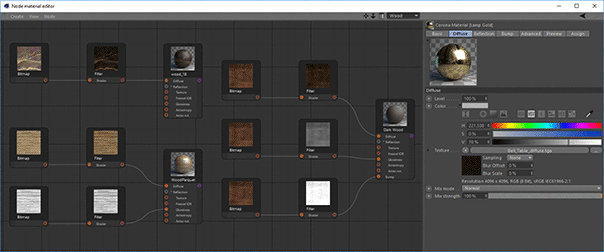
It can handle almost any sort of material
You don’t need to create a special material to use the Corona Node Material Editor. This means that any existing materials can simply be dropped into it, to take advantage of this visual way of working with them.
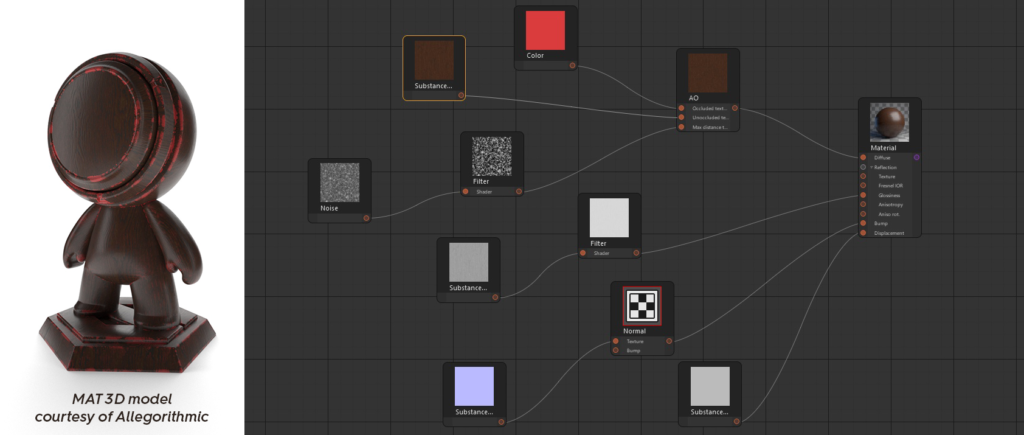
It also works with native Cinema 4D materials and shaders, Substance shaders, etc.
You can connect one shader to any number of channels, or any number of materials
Natively in Cinema 4D, if you attach a Noise map to the Diffuse for example, then want to add the same Noise map to the Bump, you end up with two separate Noise maps and have to edit or adjust both whenever you want to change them.
The same applied if you wanted to connect a shader to more than one material – you would end up with separate copies of the shader, and would have to modify the parameters in two (or more) places to keep things matching.
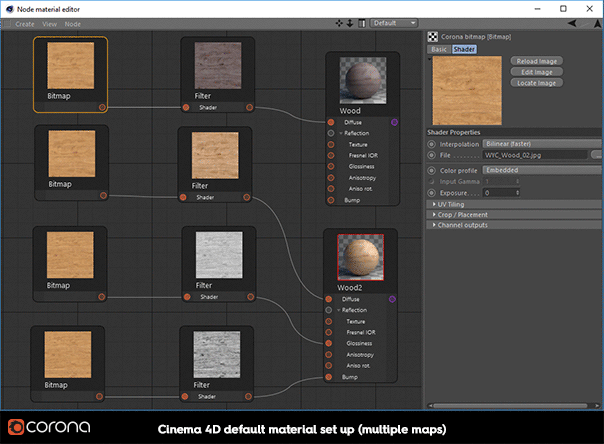
Using the Corona Node Material Editor, you can now connect one shader to as many channels – and to as many materials – as you like; change that one shader, and you affect all the channels and materials it is connected to (behind the scenes, this is done using a new Corona Shared shader, but you never need to know or think about that and can just draw your connections to hook up your shaders any way you like!)
It works with the native Layer shader
The native Layer shader is a bit of a different animal from most shaders – for one thing, the number of connections to it can change depending on how many layers you want, and its UI changes accordingly too.
It took some clever work, but we have the native Layer shader working perfectly in the Corona Node Material Editor, including being able to use Folders!
And you can use the native Layered material too – and mix and match all this functionality in any way you want.
You can edit in the Corona Node Material Editor, or in the native C4D material editors
You can swap back and forth between how and where you edit your materials, without having to worry. It’s up to you how you want to work with your materials!
Lots of functionality to ensure ease of use
As you’d expect from Corona Renderer, there are lots of features to make sure your workflow runs smoothly, such as auto-sorting of the node layout, select by selection box, CTRL + Drag to copy the selected nodes, and more.
It is not dependent on which version of Cinema 4D you are running
Since the Corona Node Material Editor is part of Corona Renderer, it will run in any version of Cinema 4D that supports Corona Renderer (R19, R18, etc.)
The Corona Hair and Skin Materials
Skin is one of the most complex materials to render, with many properties unique to skin that cannot be covered in an all-purpose shader. The Corona Skin Material shader has been added, and it makes it easy to control and adjust the look of the skin, and renders fast and efficiently with realistic results. Even if you have never tried rendering realistic skin before, you’ll find it easy to use and will get great results with the default settings.
Hair has particular unique qualities that also need a dedicated shader. The Corona Hair Material shader is physically accurate, and handles the unique highlights and transmission properties that hair requires, while still rendering quickly and giving you the ease of use in controlling the material that you expect from Corona Renderer.
Cinema 4D has a somewhat unique approach to hair, in that the Cinema 4D Hair Material actually creates the hair geometry (rather than separate geometry creation and shading). To be able to render hair at the moment, you’ll need to use both the Cinema and Corona Hair materials together – this will be improved in the next release, when we will also fully support the Cinema 4D hair material by internally automatically converting it to the Corona Hair Material.
New Motion Blur implementation
A new implementation of Motion Blur has been added, which works with both Interactive and offline rendering.

This new implementation was required, as the old version was the source of some instability in Corona Renderer.

This new implementation also properly supports simulation, and the motion blurring of instanced objects is greatly improved.
Scene Converter, and Implicit Conversion
Implicit conversion allows Corona to render non-Corona materials and lights, without the need to convert them first. There is also a Scene Converter included, which will carry out explicit conversion (that is, permanently change a non-Corona material or light into a Corona one.)
For explicit conversion, we support the conversion of standard Cinema 4D materials and lights, and the conversion of the following V-Ray items – Standard, Advanced, Displacement and 2-Sided V-Ray materials (V-Ray must be installed); Physical Sun + Sky, Area, Spot, and Omni V-Ray lights; and AdvBitmap and PowerShaders V-Ray shaders. Note – to be able to convert a scene from V-Ray, you will have to have V-Ray installed for Cinema 4D.
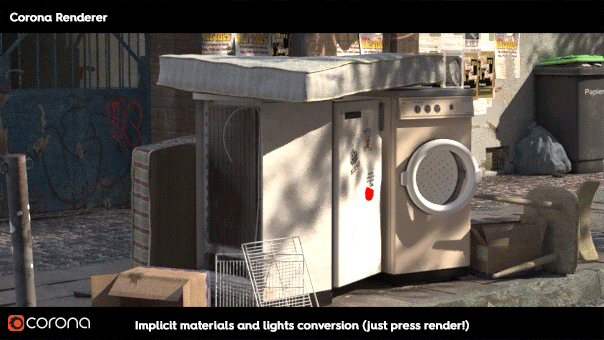
Of course, a perfect conversion is nearly impossible. For example, Cinema 4D has lights that are not physically based, and when you use those non-physical options conversion is difficult because Corona Renderer doesn’t have counterparts for them. The same applies to certain parameters in some materials, and so some scenes may have quite different lighting after conversion because some materials that should be transparent may be opaque, for example.
The main purpose of the explicit scene converter is to help you migrate your scenes to Corona Renderer so that you don’t need to set up your materials and lights from scratch and instead need to only tune the parameters after conversion.
For implicit conversion, the main purpose is to let you check how the scene will look in Corona Renderer without having to actually convert it (it will give you an idea of what will convert perfectly, and what might need some tweaking after conversion).
While no conversion will ever be 100% identical, we will be continually improving conversion based on user feedback!
UVW Randomizer and Triplanar shaders
The Corona UVW Randomizer map allows applying random offset / rotation / scale to textures and maps applied to different objects. For example, you can randomize a wood texture applied to a set of planks so that each has a different look in your final render.
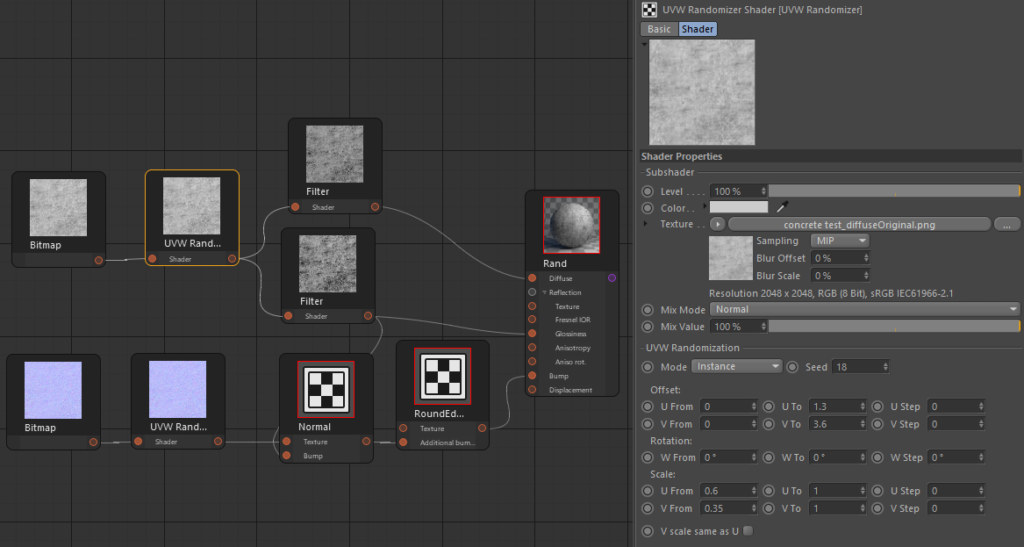
Triplanar mapping is useful for applying textures to objects without having to explicitly unwrap their UVWs. It prevents visible seams by introducing blending between the applied maps, and it does not produce stretching, which is characteristic to standard planar mapping.
In the image below, this free model by Rigsters was downloaded from Sketchfab. On import, as expected it has no UV mapping, and applying a bitmap gives a solid color. Applying a simple default UV tag does not help, as it gives a distorted texture. Rather than come up with a good UV unwrap for the object, all we need to do is apply the Corona Triplanar map (without ever needing to apply a UV Tag at all):
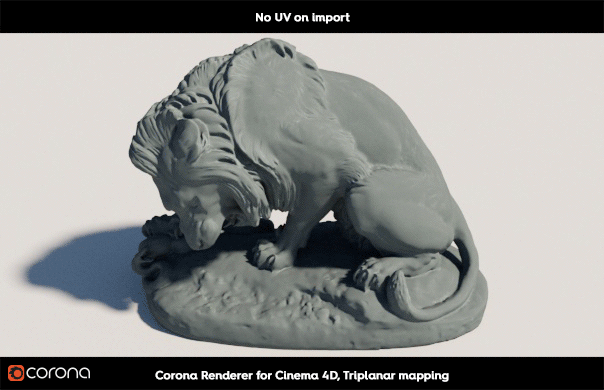
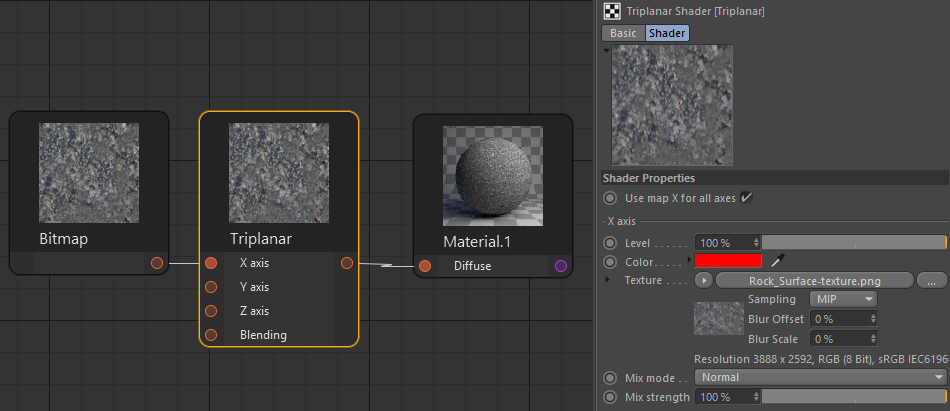
You can also be creative with the Triplanar map – in the example below, Triplanar was used as a mask between two separate materials in the Layer shader, so that vertical surfaces appear like ice, while flat surfaces have a more earth or mud appearance, all without having to do any sort of UV mapping:
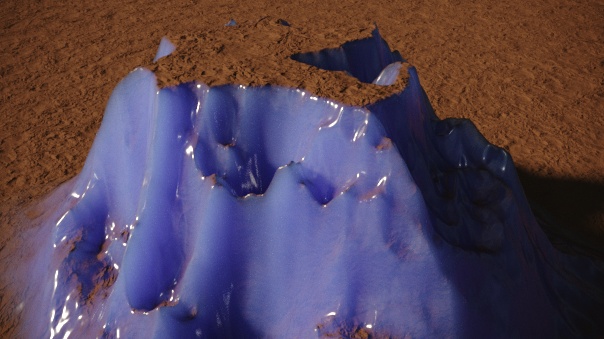
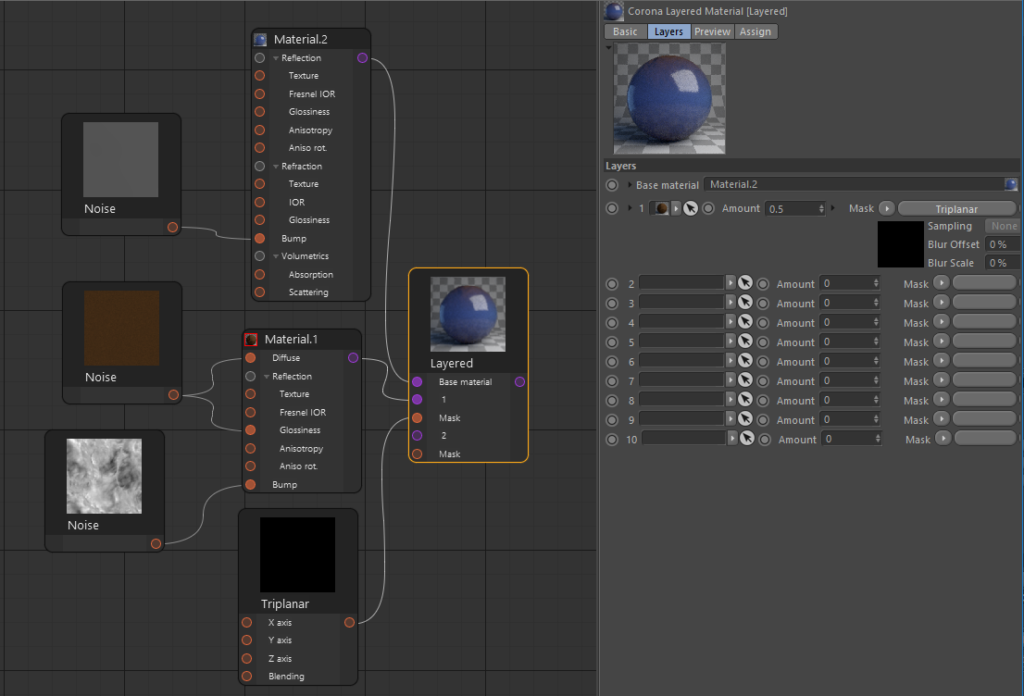
New Bokeh Effects
The Corona Camera now adds advanced Bokeh controls for Center Bias, Vignetting and Anisotropy.
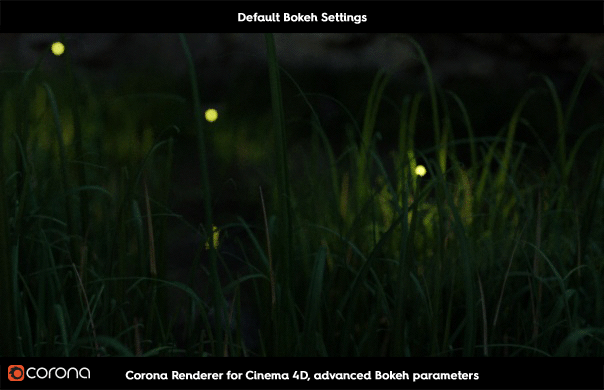
Positive values of Center Bias expand the bokeh into rings, while negative values compress the bokeh highlights.
Positive values of Vignetting give a harder edge to the Bokeh toward the outside of the image, while negative values create a harder edge to the Bokeh highlights toward the center of the image.
Anisotropy affects the aspect ratio of the bokeh effect, with values above 0 stretching it horizontally, and below 0 stretching it vertically.
Team Render Improvements
Team Render now supports Denoising, and stopping by Noise and Time limits.
Support for C4D R20
Both Windows and macOS installers now include a version of Corona Renderer for Cinema 4D R20, and it is automatically detected during installation so you can easily start using Corona Renderer without any problem.
Note – there is no API from Maxon for R20’s Node Materials yet, so these will not render using Corona Renderer at this time.
Transform Your Creative Projects with 3D Plugins for After Effects, Cinema 4D, and OFX
Elevate your visual storytelling and design capabilities with cutting-edge 3D plugins tailored for After Effects, Cinema 4D, and OFX. These powerful tools empower creators to seamlessly integrate stunning 3D elements, dynamic animations, and breathtaking effects into their projects. Whether you’re a motion graphics artist, video editor, or visual effects professional, our 3D plugins offer unmatched versatility and precision, making your creative visions a reality. Explore the ultimate toolkit for crafting immersive visuals that captivate audiences and set your work apart.
Unlock New Creative Dimensions with 3D Plugins for After Effects, Cinema 4D, and OFX
Discover the next level of visual effects and animation with our advanced 3D plugins designed for After Effects, Cinema 4D, and OFX platforms. These plugins offer a comprehensive suite of tools that enable you to create intricate 3D models, realistic textures, and dynamic animations with ease. Perfect for motion designers, VFX artists, and animators, our plugins simplify complex workflows, allowing you to achieve professional-grade results in less time.
Whether you’re working on a high-end commercial, an indie film, or digital content for social media, these 3D plugins provide the flexibility and power needed to bring your creative ideas to life. With features like real-time rendering, intuitive controls, and seamless integration with your existing software, you can push the boundaries of what’s possible in your projects.
Our plugins are optimized for performance, ensuring smooth operation even with the most demanding scenes. Plus, with regular updates and a supportive community of users, you’ll always have the latest tools and resources at your fingertips. Elevate your work with the precision, detail, and depth that only top-tier 3D plugins can provide.
➡️ ➡️ For more after effects Plugins 😀 😀
➡️ ➡️ For more 3D Plugins 😀 😀
System Requirement For adobe after effects


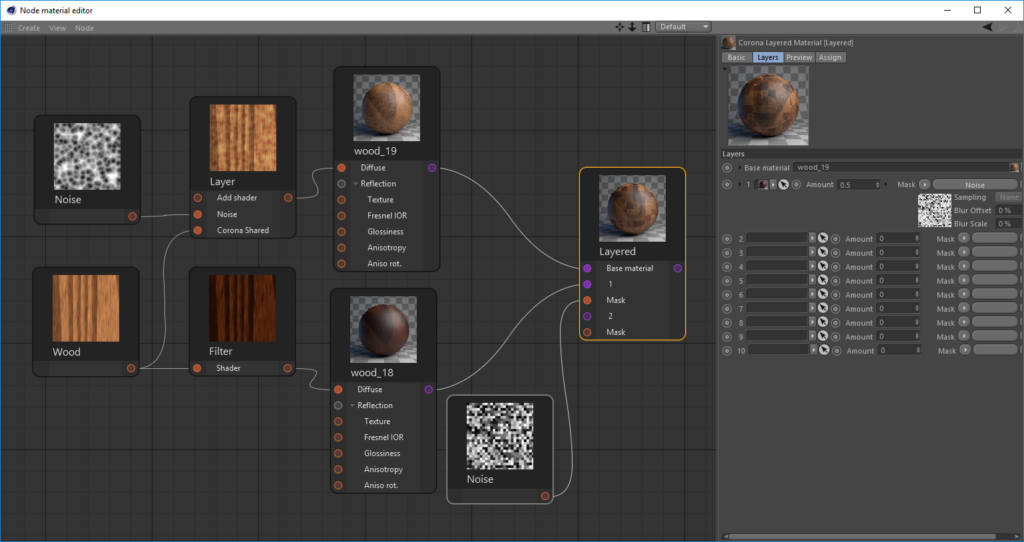
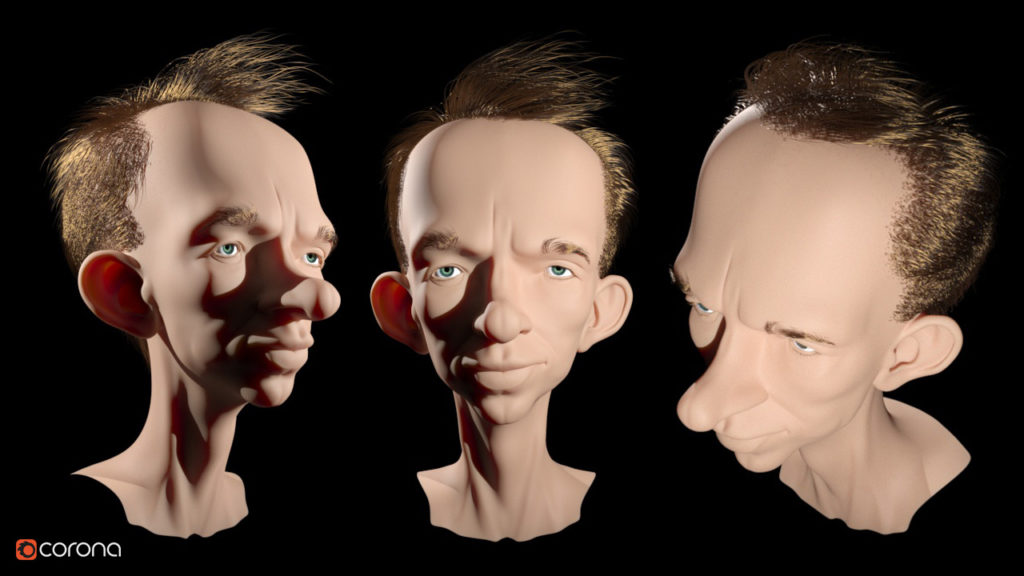

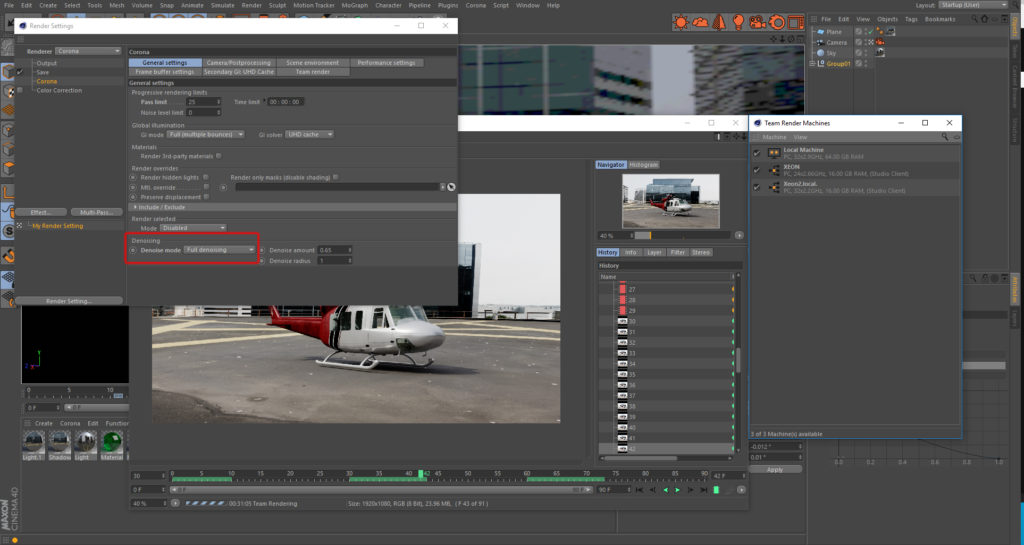
Reviews
There are no reviews yet.